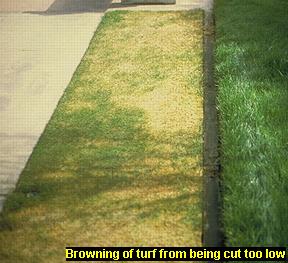Thanks for taking your time to view our info!

We have experienced an extremely wet summer this year. We have had rain days for approx 70% of the time (21 days out of the month), usually it is around 25 – 35% (10days out of the month). The Gold Coast Bulletin ran a front page story stating that there has only been 11 clear days in the last 2 months!
All of this rain / water has three (3) major detrimental effects –
1. The Rain Drowns the turf – (this sounds worse than what it actually is). Oxygen is vital for turf growth and development. Turf / plants absorb oxygen through the soil, when there is an excessive amount of rainfall the areas in the soil that were full of oxygen (called ‘pores’) are now filled with water. Therefore there is no oxygen available for the turf. Hence the term ‘drowning’
SOLUTION – ensure that you have adequate drainage and / or topdress your lawn with 5mm of course sand. As the sand is a larger particle size than the topsoil more spaces (‘pores’) for oxygen and water will be created. The topdressing with sand theory is similar to filling a large 44 gallon drum up with basketballs (sand) OR filling a large 44 gallon drum up with golf balls (topsoil). The particles are bigger and therefore creates more spaces for the oxygen and roots of the turf.
2. Lack of Sunlight – sunlight is food for the grass, the sunlight is absorbed through the leaves of the grass / plant (photosynthesis, remember yr 11 biology….) When there is an excessive amount of rain days then there is little or no sunlight for the grass to absorb. The clouds and rain days have taken away the food source for your turf.
SOLUTION – When mowing your turf lift / raise the height of your lawn mower. This will increase the amount of leaf area available to absorb sunlight. When the sun does come out regularly again, slowly move the mowing height back down. (Remember to only remove 1/3 of the leaf at any one time).
3. Lack of nutrients – with a lack of sunlight the grass is forced to draw nutrients from its reserve it has stored in the roots. This works quite for well for a short period of time. (it is similar to a kitchen pantry, it has food stored in it but if you don’t go shopping or re-fill it the food will run out…..) . The cloudy and wet days create a limited amount of sunlight and only a small window of opportunity to absorb nutrients.
SOLUTION – to help compensate for the lack of nutrients in the grass we need to make it as easy as possible for the turf to absorb nutrients from the soil. We can achieve this by applying a chemical fertilzier. The fertilizer will provide very EASY nutrients for the grass. This fertilzier application will not have the usual jump oout of the ground effect that it usually does in hot summer months, what it will do is provide a ‘LIFE SUPPORT’ system for your struggling turf.
The only other advice that I can offer is PATIENCE. Unfortunately we cannot control the weather, therefore we must manage ourselves and our lawns around it. Im sure that if you follow these tips and apply some PATIENCE your lawn will be back to looking like a bowling green in no time !
Talk to you soon,
Robbie Commens


